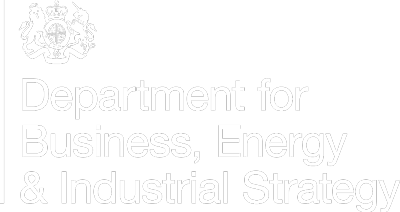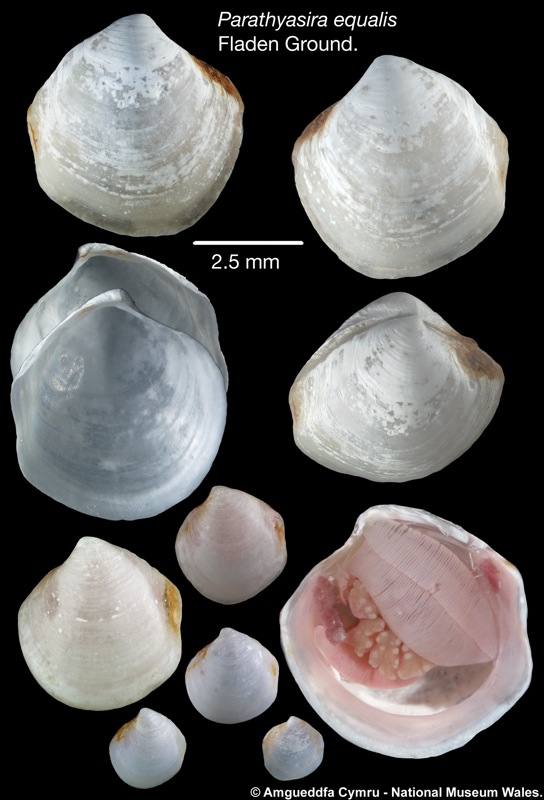Thyasira equalis (Verrill & Bush, 1898)
Thyasiroidea : Thyasiridae |
| Tebble name: | n/a |
| Smith & Heppell name: | Thyasira equalis Verrill & Bush, 1898 |
To size: To 8mm. Shell Structure: Thin, fragile. Equivalve: Equivalve. Equilateral: Equilateral. Tumidity: Not inflated. Outline: Ovate-rhomboidal: inner anterior dorsal margin sloping steeply, depressed; distinct outer anterior dorsal margin short obliquely truncate; anterior narrowly rounded; ventral round to a little angulate; posterior margin truncate to slightly sinuous; posterior dorsal margin long sloping steeply. Contour: Submarginal sulcus long, edges sharply angled, no auricle; posterior area flattened or as a shallow sinus; when anterior dorsal truncation present accompanied by a low ridge. Larval shell 155-180microns with weak radiating wrinkles.
Sculpture: Smooth with growth lines only, often chalky and eroded. Margin: Smooth. Ligament: External, deeply sunken scarcely visible. Hinge: Hinge plate weak, indistinct cardinal protuberance in RV, corresponding depression in LV. Pallial Musculature: Muscle scars obscure. Periostracum: Not persistent. Colour: Shell white often with ferruginous deposits on anterior dorsal truncation and posterior. Additional Characters: 2 demibranchs.
Distribution & Ecology
Also from the shelf of Scandinavia.
Partial chemotrophic, suspension feeder, symbiosis partial, gills sometimes with bacterial symbionts but not highly adapted, 2 demibranchs. In British waters confined to deep shelf areas of the North Sea in muddy sands
Gross anatomy – Payne & Allen, 1991
Gill anatomy – Dufour, 2005
Symbiosis – Dando & Spiro, 1993
Depth Range
Continental Shelf (to 200m)
Continental Margin Zone (200 - 500m)
Bathyal (500 - 2000m)

Additional Information & Related Species
Additional Comments
Other similar shells from upper slope of Atlantic margin not considered to be conspecific, see T. spA
Related Species
Thyasiroidea : Thyasiridae
References
Listed are literature citing Thyasira equalis (Verrill & Bush, 1898). Reference containing the species Type Description is highlighted.
|
Dando P R & Spiro B 1993. Varying nutritional dependence of the thyasirid bivalves Thyasira sarsi and T. equalis on chemoautotrophic symbiotic bacteria, demonstrated by isotope ratios of tissue carbon and shell carbonate. Marine Ecology Progress Series . 92: 131-158. |
|
Dufour S C 2005. Gill anatomy and the evolution of symbiosis in the bivalve family Thyasiridae. Biological Bulletin. 208: 200-212. |
|
Olabarria C. 2005. Patterns of bathymetric zonation of bivalves in the Porcupine Sea Bight and adjacent abyssal plain, NE Atlantic. Deep-Sea Research I. 52: 15-31. |
|
Oliver P G & Killeen I J 2002. The Thyasiridae (Mollusca: bivalvia) of the British continental shelf and North Sea Oilfields. Studies in Marine Biodiversity and Systematics from the National Museum of Wales. BIOMOR Reports. 3: 1-73. |
|
Payne C.M. & Allen J.A. 1991. The morphology of deep-sea Thyasiridae (Mollusca: Bivalvia) from the Atlantic Ocean. Philosophical Transactions of the Royal Society of London Series B. 334: 481-566. |
|
Verrill A E & Bush K J 1898. Revision of the deep water Mollusca of the Atlantic Coast of North America with descriptions of new genera and species Part 1 Bivalvia. Proceedings of the United States National Museum. 20: 775-901. |
Resources
- Conchological Society
of Great Britain & Ireland
Provides resources for understanding, identifying, recording, and conserving molluscs - CLEMAM
Check List of European Marine Mollusca - MarLIN
The Marine Life Information Network for Britain and Ireland (MarLIN) provides information for marine environmental management, protection and education. It is a centre of excellence in spatially based and time-series marine biological information and supports good stewardship in the marine environment. - NBN Gateway
National Biodiversity Network's Gateway. Use it to explore UK biodiversity data, as contributed by participating data providers. - BivAToL
- MarBEF
- Malacological Society
- Unitas Malacologica
- Census of Marine Life
- MarBEF
MarBEF, a network of excellence funded by the European Union and consisting of 94 European marine institutes, is a platform to integrate and disseminate knowledge and expertise on marine biodiversity, with links to researchers, industry, stakeholders and the general public.













